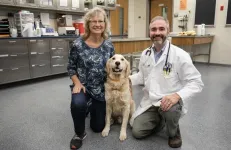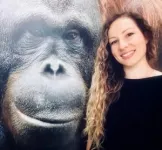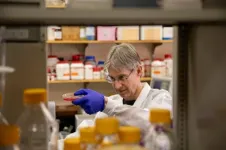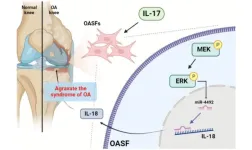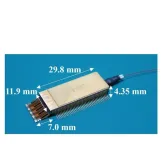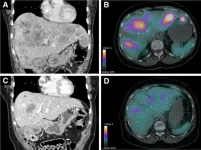(Press-News.org) For the first time, Purdue researchers prove that measuring mechanical motions in living cancer tissues is a viable and promising approach for predicting chemoresistance
Chemotherapy can save lives, but often a cancer patient may be resistant to their prescribed chemotherapy, which costs the patient valuable time. Chemoresistance is a topic that researchers need to understand better so that they can match the right type of chemo to the right patient, which is called personalized medicine.
An unusual pairing of veterinary scientists and physicists believe their method of detecting chemoresistance could be the new standard for personalized medicine. Their method is unexpected: Doppler ultrasound. Many people may have heard the term Doppler, either from the weather reports to detect storm activity or expectant parents who see their unborn child for the first time.
Now, a team of physicists and veterinary scientists at Purdue University is using ultrasound to detect how cancer cells respond to chemotherapy. They currently have their method of personalized chemotherapy detection in Phase-2 clinical trials in humans at the IU School of Medicine and have also been using the method in canine trials. The concept was born in 2015 by three researchers at Purdue: David Nolte, principal investigator and Edward M. Purcell Distinguished Professor of Physics and Astronomy, John Turek, Professor of Basic Medical Sciences, and Michael Childress, Professor of Comparative Oncology. Nolte is from the Department of Physics and Astronomy at the Purdue College of Science and Turek and Childress are from the Purdue College of Veterinary Medicine. All three are members of the Purdue University Institute for Cancer Research and have published their findings in Scientific Reports. Also listed as authors on this paper are three students of Nolte — Zhen Hua and Zhe Li, both former PhD students, and Dawith Lim, a current PhD student — as well as the IU School of Medicine team of Shadia Jalal, M.D., Ali Ajrouch and Ahmad Karkash.
“The technique developed at Purdue measures motions inside cancer cells and how these motions change when the cells are exposed to anticancer drugs,” explains Nolte. “Because motion is the result of cellular ‘machinery,’ patients who will respond positively to their chemotherapy show different mechanical responses to the drugs than patients who will not respond. This has the potential to identify patients for whom chemotherapy will not be successful so they can be directed to more effective treatment.”
The technique, called biodynamic imaging (BDI), has been under development for cancer treatments for over eight years. The team has published their findings previously, noting that the technique showed potential for identifying chemoresistance, but only under fairly restricted disease conditions. This raised the question of whether BDI might be useful only for special cases.
“The current research shows that BDI is, in fact, a general and robust technique,” says Nolte. “It shows similar results across two species (human and canine) and two diseases (lymphoma and esophageal cancer). This provides, for the first time, strong evidence that measuring mechanical motions in living cancer tissues is a viable and promising approach for predicting patient chemoresistance.”
The concept of using Doppler in cancer research seems an unlikely scenario. According to Nolte, the concept and process for this technique was born out of basic scientific experimentation. He said the concept was fine-tuned with the benefit of serendipity combined with slow and steady progress.
“We began the work on cancer tissue cultures grown in the lab, so it was natural to eventually move to fresh tumors from patients,” he explains. “The Doppler measurements were something that we were led to during our experiments as we noticed interesting dynamical effects that we had not initially anticipated.”
This team formed well over two decades ago. Back in 1999, the Office of the Purdue Executive Vice President for Research hosted a meeting of Purdue faculty interested in various aspects of imaging.
“Dr. Nolte and I met at that meeting, and we started working on using the technology with 3D tumor spheroids (small tumors grown in culture) that I grew in my lab,” says Turek. “We worked with tumor spheroids for a number of years as the technology developed. When it was time to move to patient derived tumors, we approached Dr. Childress and used samples from canine lymphoma patients to track their response to drugs. Working with the canine samples was necessary to determine the feasibility of translating the technology to human samples. From canine samples we moved on to human samples. Our collaboration with Dr. Shadia Jalal of the IU School of Medicine has been an invaluable and critical component to the research.”
“The major advantage to using canine tumors as opposed to tumors from laboratory mice is that the former better represent the heterogeneity of human cancers,” says Childress. “Although all the dogs we studied had the same cancer type – lymphoma – each individual dog’s cancer was unique, with some more sensitive and others more resistant to chemotherapy. This provided an ideal animal model in which to study a predictive technology like BDI before advancing it to human trials.”
Cells in all living creatures have working machinery that is very finely tuned. When outside influences disturb the cellular machinery, the mechanical motions change. If scientists can see a difference in those changes between patients whose cancers are sensitive to treatment versus those who are not, they can learn those signatures and use them to predict chemoresistance in future patients.
“A deeper question is what the signatures mean,” explains Nolte. “Can signatures of chemoresistance be interpreted in terms of changes in the signaling pathways in cells and tissues and possibly even genetic expression? This is much harder to answer, but we are currently working on this question by comparing our measurements to gene expression profiles. We also use reference compounds that have known behavior in cells and we can cross-reference our measurements with the known changes that occur under those drugs. This part of the research is long-term.”
Nolte says that Purdue has strong support for cross-disciplinary research which significantly aids in how this type of research develops. Coupling that with the benefit of the Purdue University Small Animal Hospital at the College of Veterinary Medicine enables the team to arrange for clinical trials with canine patients. Now that they have received these promising results, the team expects their next giant leap in cancer research to include “prospective” Phase 2 trials.
“The current Phase 2 was retrospective, where the patient clinical response was cross-validated against the predicted response using BDI. The next step is a Phase 2 trial that is ‘prospective,’ meaning that we will predict patient response prior to the beginning of chemotherapy,” says Nolte.
This research is funded in part by the National Science Foundation (NSF) CBET (Division of Chemical, Bioengineering, Environmental and Transport Systems), the American Kennel Club Canine Health Foundation, and the Purdue Institute for Cancer Research.
About Purdue University
Purdue University is a public research institution demonstrating excellence at scale. Ranked among top 10 public universities and with two colleges in the top four in the United States, Purdue discovers and disseminates knowledge with a quality and at a scale second to none. More than 105,000 students study at Purdue across modalities and locations, including nearly 50,000 in person on the West Lafayette campus. Committed to affordability and accessibility, Purdue’s main campus has frozen tuition 13 years in a row. See how Purdue never stops in the persistent pursuit of the next giant leap — including its first comprehensive urban campus in Indianapolis, the new Mitchell E. Daniels, Jr. School of Business, and Purdue Computes — at https://www.purdue.edu/president/strategic-initiatives.
About the Department of Physics and Astronomy at Purdue University
Purdue Department of Physics and Astronomy has a rich and long history dating back to 1904. Our faculty and students are exploring nature at all length scales, from the subatomic to the macroscopic and everything in between. With an excellent and diverse community of faculty, postdocs, and students who are pushing new scientific frontiers, we offer a dynamic learning environment, an inclusive research community, and an engaging network of scholars.
Physics and Astronomy is one of the seven departments within the Purdue University College of Science. World-class research is performed in astrophysics, atomic and molecular optics, accelerator mass spectrometry, biophysics, condensed matter physics, quantum information science, particle and nuclear physics. Our state-of-the-art facilities are in the Physics Building, but our researchers also engage in interdisciplinary work at Discovery Park District at Purdue, particularly the Birck Nanotechnology Center and the Bindley Bioscience Center. We also participate in global research including at the Large Hadron Collider at CERN, many national laboratories (such as Argonne National Laboratory, Brookhaven National Laboratory, Fermilab, Oak Ridge National Laboratory, the Stanford Linear Accelerator, etc.), the James Webb Space Telescope, and several observatories around the world.
About Purdue University College of Veterinary Medicine:
The Purdue University College of Veterinary Medicine seeks to advance global animal and human health and well-being through excellence in learning, discovery and engagement. Home to the Purdue University Veterinary Hospital and Animal Disease Diagnostic Laboratory, the college serves as a major referral center for the diagnosis and treatment of animal diseases. Faculty research both animal and human health, with an emphasis on infectious diseases and immunology; cancer; neuroscience; musculoskeletal biology and orthopedics; and animal welfare science and the human-animal bond. The college is also one of only a few nationally that educate all members of the veterinary team. Students may pursue the Doctor of Veterinary Medicine degree, bachelor's or associate degrees in Veterinary Nursing, post-graduate internships and residencies for specialty training, or graduate degrees in Basic Medical Sciences, Comparative Pathobiology, or Veterinary Clinical Sciences. For more information visit www.vet.purdue.edu.
Contributors:
David Nolte, Edward M. Purcell Distinguished Professor of Physics and Astronomy
John Turek, Professor of Basic Medical Sciences
Michael Childress, Professor of Comparative Oncology
Written by Cheryl Pierce, Communications Specialist
END
Researchers edge closer to delivering personalized medicine to cancer patients
2024-02-14
ELSE PRESS RELEASES FROM THIS DATE:
Trail cameras track ‘critically low’ New York bobcat population
2024-02-13
CORNELL UNIVERSITY MEDIA RELATIONS OFFICE
FOR RELEASE: Feb. 13, 2024
Kaitlyn Serrao
607-882-1140
kms465@cornell.edu
Trail cameras track ‘critically low’ New York bobcat population
ITHACA, N.Y. – With thousands of strategically placed cameras covering more than 27,000 square miles in central and western New York, biologists have evidence that bobcat populations remain critically low in central and western New York state.
Despite reports of recent recoveries elsewhere, bobcat populations in New York State displayed low occupancy, ...
Virginia Tech researchers discover that blocking an essential nutrient inhibits malaria parasite growth
2024-02-13
Living organisms often create what is needed for life from scratch.
For humans, this process means the creation of most essential compounds needed to survive. But not every living thing has this capability, such as the parasite that causes malaria, which affected an estimated 249 million people in 2022.
Virginia Tech researchers in the College of Agriculture and Life Sciences found that by preventing the malaria parasite from scavenging fatty acids, a type of required nutrient, it could no longer grow.
“The key to this breakthrough is that we were able to develop a screening method for the malaria ...
Children's Hospital Los Angeles researchers uncover social and economic factors that influence acute liver failure in children—and ways to overcome them
2024-02-13
Imagine your healthy child gets sick—so sick that you take them to the emergency department. You are shocked to find out that their liver is failing, and they will need a transplant to survive. Studies show that their chances of survival are higher the faster they can get to a hospital that performs liver transplants. But what factors affect how quickly that happens?
Pediatric acute liver failure, also called PALF, is a life-threatening condition that emerges with very little warning in previously healthy children. It is rare, affecting about 5,000 children in the United States a year, and can result from viral ...
Uncovering insights about prostate cancer risk and genetic ancestry
2024-02-13
This study included larger groups of people from African, Hispanic and Asian ancestries than many other previous studies.
A recent study involving scientists from the U.S. Department of Energy’s (DOE) Argonne National Laboratory has uncovered insights into the prostate cancer risks of people from a variety of genetic ancestries. The project, which was led by the University of Southern California, included large increases in representation among men of African, Hispanic and Asian ancestries, that were contributed in part by an ongoing collaboration between the U.S. Department of Veterans Affairs (VA) and DOE as ...
A century of reforestation helped keep the eastern US cool
2024-02-13
American Geophysical Union
13 February 2024
AGU Release No. 24-5
For Immediate Release
This press release and accompanying multimedia are available online at: https://news.agu.org/press-release/a-century-of-reforestation-helped-keep-the-eastern-us-cool/
A century of reforestation helped keep the eastern US cool
Much of the U.S. warmed during the 20th century, but the eastern part of the country remained mysteriously cool. The recovery of forests could explain why
AGU press contact:
Liza Lester, +1 (202) 777-7494, news@agu.org (UTC-5 hours)
Contact information for the researchers:
Kim ...
IL-17 promotes IL-18 production in osteoarthritis synovial fibroblasts via…
2024-02-13
“This study provides novel insights into the pathogenesis of OA and suggests a potential therapeutic target in OA treatment.”
BUFFALO, NY- February 13, 2024 – A new research paper was published in Aging (listed by MEDLINE/PubMed as "Aging (Albany NY)" and "Aging-US" by Web of Science) Volume 16, Issue 2, entitled, “IL-17 promotes IL-18 production via the MEK/ERK/miR-4492 axis in osteoarthritis synovial fibroblasts.”
The concept of osteoarthritis (OA) as a low-grade inflammatory ...
New data speed record on optical fiber
2024-02-13
As data traffic continues to increase, there is a critical need for miniaturized optical transmitters and receivers that operate with high-order multi-level modulation formats and faster data transmission rates. In an important step toward fulfilling this requirement, researchers developed a new compact indium phosphide (InP)-based coherent driver modulator (CDM) and showed that it can achieve a record high baud rate and transmission capacity per wavelength compared to other CDMs. CDMs are optical transmitters used in optical communication systems that can put information on light by modulating the amplitude and phase before it is transmitted through optical fiber.
“Services that require ...
UBCO researchers get to the bottom of non-invasive gut tests
2024-02-13
New research from UBC Okanagan could make monitoring gut health easier and less painful by tapping into a common—yet often overlooked—source of information: the mucus in our digestive system that eventually becomes part of fecal matter.
Correct, what’s in our poop.
Researcher Dr. Kirk Bergstrom and post-graduate student Noah Fancy of UBCO's Biology department discovered a non-invasive technique to study MUC2, a critical gut protein, from what we leave behind in the bathroom.
“MUC2 is like the silent star in our guts. It’s constantly working ...
Radiopharmaceutical therapy controls symptoms and reduces medications in insulinoma patients
2024-02-13
Reston, VA—Peptide receptor radionuclide therapy (PRRT) is effective for clinical control of symptomatic metastatic insulinomas, according to new research published in the February issue of The Journal of Nuclear Medicine. In the largest study to date of metastatic insulinoma patients treated with PRRT, more than 80 percent of patients had long-lasting symptom control, and nearly 60 percent were able to reduce the use of other drugs to treat the disease.
Metastatic insulinoma is a rare malignant neuroendocrine tumor characterized ...
First-of-its-kind ACC registry tracks cardiac procedures performed in ambulatory surgical settings
2024-02-13
The American College of Cardiology’s newest registry offers data-driven insights on cardiac procedures performed in the ambulatory surgery setting through its first-of-its-kind dashboard. The number of cardiac procedures being performed in ambulatory surgery centers has grown significantly in the last decade, leading ACC’s NCDR to create the CV ASC Registry Suite to fit into the established workflow and allow these facilities to measure and compare their patient care and outcomes to similar procedures performed in the hospital outpatient setting.
Ambulatory surgery centers (ASCs) are health care facilities that provide same-day surgical care, ...
